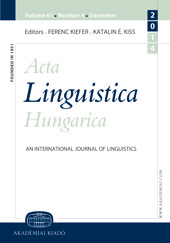“The true mystery of the world is the visible, not the invisible”: Some reflections on the verbal morphophonology of Balearic Catalan
“The true mystery of the world is the visible, not the invisible”: Some reflections on the verbal morphophonology of Balearic Catalan
Author(s): Clàudia Pons MollSubject(s): Phonetics / Phonology, Morphology
Published by: Akadémiai Kiadó
Keywords: Catalan verbal morphophonology; Optimality Theory; Paradigmatic Contrast (formalization); Optimal Paradigms; Anti-Faithfulness constraints;
Summary/Abstract: In Balearic Catalan, first person singular present indicative verb forms do not show an explicit inflectional morph, as do most dialects of Catalan. Among these forms, we find final consonant clusters that involve a violation of the sonority constraint according to which the degree of sonority between the segments of a syllable must be decreasing in relation to the nucleus. The same clusters in nominal inflection are resolved by means of a process of vowel epenthesis. The exceptional phonological behavior of these consonant clusters is not circumscribed to sonority factors, but also concerns the regular phonology of the dialect, either because a general process fails to apply, or because a process applies though the conditions that make it applicable are not visible. Previous approaches have analyzed these final consonant clusters, not as codas, but as onsets of empty nuclei: this exceptional syllabic status would, according to these proposals, throw some light on this peculiar phonological behavior. In this paper we investigate the theoretical problems deriving from approaches of this kind and demonstrate that they are better analyzed by considering paradigmatic effects, such as uniformity and contrast between the members of a morphological paradigm. Furthermore, we critically review the different theories developed in Optimality Theory in order to account for surface resemblances and dissimilarities between the members of a paradigm and introduce a detailed formalization of Paradigmatic Contrast .
Journal: Acta Linguistica Hungarica (Since 2017 Acta Linguistica Academica)
- Issue Year: 54/2007
- Issue No: 3
- Page Range: 295-339
- Page Count: 45
- Language: English

